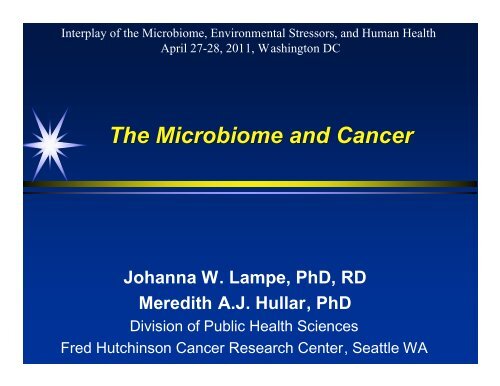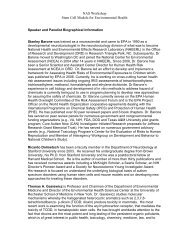The Gut Microbiome and Cancer Risk in Humans The Gut ...
The Gut Microbiome and Cancer Risk in Humans The Gut ...
The Gut Microbiome and Cancer Risk in Humans The Gut ...
You also want an ePaper? Increase the reach of your titles
YUMPU automatically turns print PDFs into web optimized ePapers that Google loves.
Interplay of the <strong>Microbiome</strong>, Environmental Stressors, <strong>and</strong> Human Health<br />
April 27-28, 2011, Wash<strong>in</strong>gton DC<br />
<strong>The</strong> <strong>Microbiome</strong> <strong>and</strong> <strong>Cancer</strong><br />
Johanna W. Lampe, PhD, RD<br />
Meredith A.J. Hullar, PhD<br />
Division of Public Health Sciences<br />
Fred Hutch<strong>in</strong>son <strong>Cancer</strong> Research Center, Seattle WA
<strong>Cancer</strong><br />
§ Class of 100+ diseases <strong>in</strong> which a group of cells display:<br />
§ uncontrolled growth<br />
§ <strong>in</strong>vasion that <strong>in</strong>trudes upon <strong>and</strong> destroys adjacent tissues<br />
§ sometimes metastasis, or spread<strong>in</strong>g to other locations <strong>in</strong><br />
the body via lymph or blood<br />
Proliferative benign<br />
condition<br />
<strong>Cancer</strong><br />
§ Starts from a s<strong>in</strong>gle cell that has lost control of its normal<br />
growth <strong>and</strong> replication processes due to changes <strong>in</strong><br />
genetic <strong>in</strong>formation <strong>in</strong> the cell.<br />
§ Effect of genetic alterations or damage accumulated with<strong>in</strong><br />
cells over time.
Exposures <strong>and</strong> Cellular Processes<br />
L<strong>in</strong>ked to <strong>Cancer</strong><br />
Involvement of Microbial Processes<br />
Differentiation<br />
Proliferation<br />
Apoptosis<br />
DNA repair<br />
Exposures<br />
<strong>and</strong> Exposures microbial<br />
processes<br />
Immune<br />
function<br />
Carc<strong>in</strong>ogen<br />
metabolism<br />
Hormonal<br />
regulation<br />
Inflammation<br />
Adapted from<br />
WCRF/AICR 2007 Expert Report
Microbes <strong>and</strong> <strong>Cancer</strong><br />
§ Microbes as <strong>in</strong>fectious agents<br />
§ Account for ~20% of cancers worldwide<br />
§ Cervical, liver <strong>and</strong> gastric cancers<br />
§ Direct effects<br />
§ Microbes as modifiers of physiology<br />
§ Microbes as modifiers of exposures<br />
§ Metaboliz<strong>in</strong>g carc<strong>in</strong>ogens, chemopreventive agents<br />
§ Affect<strong>in</strong>g energetics
Helicobacter pylori Infection <strong>and</strong> <strong>Cancer</strong><br />
§ Causal factor <strong>in</strong><br />
gastric<br />
adenocarc<strong>in</strong>oma.<br />
§ Chronic colonization<br />
causes <strong>in</strong>flammation<br />
<strong>and</strong> ulceration.<br />
§ Only a fraction of<br />
colonized <strong>in</strong>dividuals<br />
develop gastric<br />
cancer.
Prevalence of Helicobacter pylori<br />
Associated with Lower <strong>Risk</strong> of<br />
Esophageal Adenocarc<strong>in</strong>oma<br />
Group by<br />
histology<br />
Study name P value Odds Ratio <strong>and</strong> 95% CI<br />
Adenocarc<strong>in</strong>oma<br />
Barrett esophagus<br />
Squamous cell carc<strong>in</strong>oma<br />
R<strong>and</strong>om effects model Less disease More disease<br />
Rokkas et al, Cl<strong>in</strong> Gastroenterol Hepatol, 5:1413, 2007
Streptococcus bovis <strong>and</strong> Colon <strong>Cancer</strong><br />
§ M<strong>in</strong>or gut colonizer <strong>in</strong> 5-16% of adults<br />
§ Cause of septicemia <strong>and</strong> endocarditis<br />
§ Strong association between S. bovis bacteremia<br />
<strong>and</strong> colorectal cancer, but debate over<br />
temporality<br />
§ Experimentally, S. bovis has been shown to:<br />
§ Promote <strong>in</strong>flammation<br />
§ Upregulate COX-2 production <strong>in</strong> vitro<br />
§ Be carc<strong>in</strong>ogenic <strong>in</strong> a rat model of colon tumorigenesis<br />
Reviewed <strong>in</strong> Burnett-Hartman et al, <strong>Cancer</strong> Epi Biomarkers Prev, 17:2970, 2008
Mechanisms by Which the <strong>Microbiome</strong><br />
May Directly Influence <strong>Cancer</strong> <strong>Risk</strong><br />
§ Reduce competition by less-desirable bacteria<br />
§ Interact with mucosal-associated immune<br />
system<br />
§ Regulate tight junctions <strong>and</strong> mucosal barrier<br />
function <strong>in</strong> epithelium<br />
§ Influence signal transduction pathways relevant<br />
to cell proliferation <strong>and</strong> apotosis<br />
§ <strong>The</strong> gut microbiota:<br />
§ <strong>The</strong> largest collection of microbes <strong>in</strong> the human<br />
body: ~10-100 trillion organisms<br />
§ 100s of species <strong>in</strong> 6 ma<strong>in</strong> phyla
Bacterial Diversity <strong>in</strong> the Human <strong>Gut</strong><br />
\<br />
>90% are<br />
Firmicutes &<br />
Bacteroidetes<br />
Only 6 major phyla<br />
Eckberg et al., 2005, Science, 308:1635-1638
<strong>The</strong> <strong>Gut</strong> <strong>Microbiome</strong> <strong>and</strong> <strong>Cancer</strong> <strong>Risk</strong><br />
<strong>in</strong> <strong>Humans</strong><br />
§ Differences <strong>in</strong> community structure may be a<br />
biomarker of adverse health outcomes<br />
Diabetes Larsen et al., 2010, PlosOne, 2:e9085<br />
IBD Marchesi et al., 2007, J Proteome Res, 6:546<br />
Obesity Turnbaugh et al., 2008, Nature, 7228:480<br />
§ Studies show differences <strong>in</strong> the human gut<br />
community associated with colorectal cancer<br />
Scanlan et al., 2008, Env. Microbiol., 10:789<br />
Sobhani et al., 2011, PlosOne, 6:e16393<br />
<strong>and</strong> adenomas Shen, X.J. et al., 2010, <strong>Gut</strong> Microbes, 1:138<br />
§ No prospective studies <strong>in</strong> humans that directly<br />
l<strong>in</strong>k changes <strong>in</strong> the gut microbiome to onset of<br />
cancer
Omnivores<br />
WE ARE WHAT WE EAT:<br />
Mammals <strong>and</strong> <strong>The</strong>ir <strong>Gut</strong> Microbes<br />
Cluster by Diet<br />
Carnivores<br />
Herbivores<br />
Ley, RE et al., Science, 2008, 320:1647
Relationship of Diet <strong>and</strong> the <strong>Gut</strong> <strong>Microbiome</strong><br />
to <strong>Cancer</strong> <strong>Risk</strong><br />
Diet<br />
Dietary<br />
constituents<br />
Fuel<br />
availability<br />
Energy<br />
imbalance<br />
<strong>Gut</strong> bacteria<br />
Normal<br />
Cells<br />
Proliferation<br />
Inflammation<br />
DNA damage<br />
Failed apoptosis<br />
Tumor
<strong>Gut</strong> Microbial Metabolism --<br />
Designed to make the most of the situation<br />
l Fermentation<br />
l Nitrate reduction<br />
l Sulfate reduction<br />
l Hydrolysis<br />
-- glycosides<br />
-- glucuronide conjugates<br />
Human<br />
digestion<br />
Food<br />
<strong>The</strong> <strong>in</strong>digestibles<br />
<strong>The</strong> leftovers<br />
Bacterial<br />
metabolism
Carbohydrates<br />
Butyrate<br />
producers<br />
Butyrate<br />
<strong>Gut</strong> Bacterial Metabolism Modify<br />
Diet Disease Relationships<br />
Consortia<br />
Phytochemicals<br />
Fat<br />
Isoflavones<br />
Glucos<strong>in</strong>olates<br />
Equol, ITC<br />
Primary bile<br />
acids<br />
Clostridia<br />
Secondary bile<br />
acids<br />
Inflammation Inflammation Inflammation Æ<br />
<strong>Cancer</strong> risk<br />
<strong>Cancer</strong> risk Æ<br />
NO 3 reducers<br />
SO 4 reducers<br />
NOC/H 2 S<br />
(toxic!)<br />
Prote<strong>in</strong><br />
Am<strong>in</strong>o Acids<br />
H +<br />
Ulcerative colitis<br />
Methane<br />
(Inert)<br />
Methanogens<br />
Diet<br />
<strong>Gut</strong><br />
Microbiota<br />
Colonic<br />
Epithelium<br />
O' Keefe SJ, 2008, Curr Op<strong>in</strong> Gastroenterol.<br />
24:1
Isothiocyanates are derived from glucos<strong>in</strong>olates<br />
<strong>in</strong> cruciferous vegetables<br />
R C<br />
N O SO3 -<br />
S-D-Glucose<br />
Glucose<br />
R C<br />
HSO 4 -<br />
..<br />
SH<br />
N O SO3 -<br />
R N C S<br />
Glucos<strong>in</strong>olate<br />
Thioglucosidase (Myros<strong>in</strong>ase)<br />
Isothiocyanate<br />
Yuesheng Zhang, Roswell Park <strong>Cancer</strong> Institute, Buffalo, NY
Inverse association between ur<strong>in</strong>ary ITC<br />
excretion <strong>and</strong> aflatox<strong>in</strong>-DNA adducts –<br />
Inter<strong>in</strong>dividual variation <strong>in</strong> ITC bioavailability<br />
§ N=200, Qidong, Ch<strong>in</strong>a<br />
§ R<strong>and</strong>omized, parallel<br />
arm, 2-week trial<br />
§ 400 umol<br />
glucos<strong>in</strong>olate/d vs.<br />
placebo<br />
§ Ur<strong>in</strong>ary ITC recovery 1-<br />
45% of 400 µmol<br />
glucos<strong>in</strong>olate dose<br />
Kensler et al, <strong>Cancer</strong> Epidemiol Biomarkers Prev, 14:2605, 2005
<strong>Gut</strong> Microbial Metabolism<br />
Modify<strong>in</strong>g Effects of Diet on <strong>Cancer</strong> <strong>Risk</strong><br />
Microbial Nitrate Reductase<br />
Nitrate<br />
NO 3 -<br />
Nitrite<br />
NO 2 -<br />
N-nitroso compounds<br />
nitrosam<strong>in</strong>es<br />
nitrosamides<br />
nitrosoguanid<strong>in</strong>e<br />
DNA adducts<br />
DNA damage
Total N-nitroso compounds (ng/ml)<br />
Microbial Community Affects Exposure<br />
to Dietary Metabolites<br />
Prote<strong>in</strong>, %<br />
Fat, %<br />
Carb, %<br />
NSP, g<br />
a<br />
13<br />
37<br />
50<br />
22<br />
a,b,csignificantly different p
Diet Shifts Microbial Community <strong>and</strong><br />
Affects Exposure to Dietary Metabolites<br />
Ma<strong>in</strong>tenance diet<br />
Axis 2 (18%)<br />
High-prote<strong>in</strong>/<br />
Low carbohydrate<br />
High-prote<strong>in</strong><br />
Moderate carbohydrate<br />
Axis 1 (29%)<br />
§ Shift <strong>in</strong> gut microbial<br />
community <strong>and</strong> metabolites<br />
with diet<br />
§ HPLC diet also:<br />
-- decreased proportion of<br />
butyrate <strong>in</strong> fecal SCFAs<br />
-- reduced Roseburia/<br />
Eubacterium rectale group<br />
of bacteria.<br />
-- reduced concentrations of<br />
fiber-derived, phenolic<br />
acids.<br />
Russell et al., Am J Cl<strong>in</strong> Nutr 2011;93:1062–72.
Number of<br />
Contigs<br />
Distribution of Metabolic Pathways<br />
<strong>in</strong> the <strong>Gut</strong> <strong>Microbiome</strong><br />
Q<strong>in</strong> et al., Nature, 2010, 464:59
Comparison of Taxanomic <strong>and</strong> Functional<br />
Variations <strong>in</strong> the Human <strong>Gut</strong> <strong>Microbiome</strong><br />
§ 18 fecal microbiomes from MZ tw<strong>in</strong>s <strong>and</strong> their mothers<br />
§ Suggests a core microbiome at the level of metabolic<br />
function with high redundancy Turnbaugh et al. Nature 2009 457:480-4
<strong>The</strong> <strong>Microbiome</strong> <strong>and</strong> <strong>Cancer</strong>:<br />
Which came first, the chicken or the egg?<br />
Challenges <strong>and</strong> Gaps<br />
STUDY DESIGN ISSUES<br />
l Lack of prospective studies<br />
l Small sample sizes<br />
l Lack of well-characterized human populations (e.g., diet <strong>and</strong> other<br />
exposures)<br />
§ Need for st<strong>and</strong>ardized collection, storage, test<strong>in</strong>g procedures<br />
THE MEASUREMENT FOCUS: An Integration of Omics<br />
Beyond the microbiome……<br />
l Metagenome<br />
l Metaproteome<br />
l Metabolome<br />
l Requires strong collaborative efforts among microbial ecologists,<br />
computational biologists, epidemiologists, nutritionists, toxicologists, etc.<br />
©PAGOT
<strong>The</strong> <strong>Microbiome</strong> <strong>and</strong> <strong>Cancer</strong><br />
Summary<br />
§ <strong>Cancer</strong> risk is comb<strong>in</strong>atorial, modified by bacterial factors,<br />
host responses, <strong>and</strong> host-microbe <strong>in</strong>teractions.<br />
§ <strong>The</strong> microbiome needs to be considered <strong>in</strong> the context of<br />
host exposures <strong>in</strong> order to underst<strong>and</strong> its impact on cancer<br />
risk <strong>and</strong> to design prevention strategies.<br />
§ Diet <strong>in</strong>fluences gut microbial community.<br />
§ <strong>Gut</strong> microbial metabolism modifies dietary components,<br />
produc<strong>in</strong>g both beneficial <strong>and</strong> harmful compounds.<br />
§ Differences <strong>in</strong> gut microbial communities are manifest <strong>in</strong><br />
metabolic phenotype differences.




